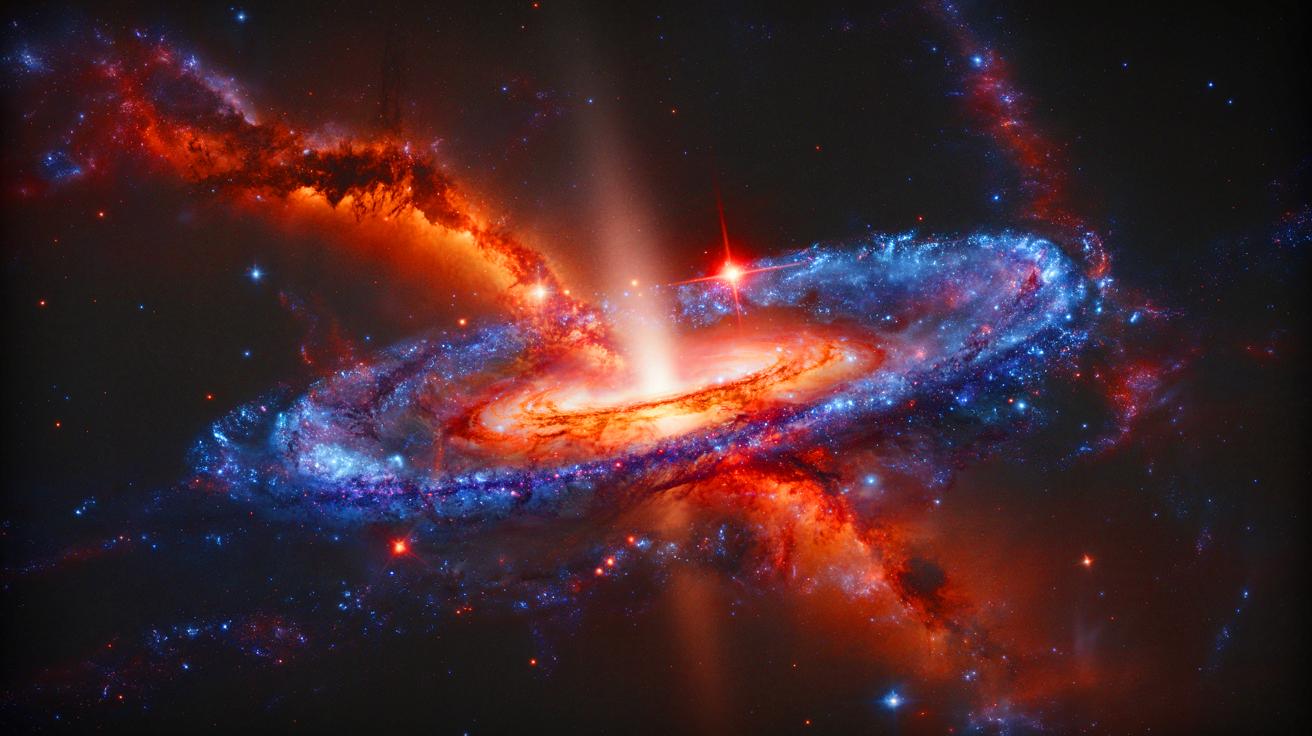IN A NUTSHELL
🌌 Astronomers discovered the “Infinity” galaxy, formed by a cosmic collision, housing a newborn supermassive black hole.
🔭 The discovery was made possible using advanced technology from the James Webb Space Telescope and other observatories.
💡 The “Infinity” galaxy challenges existing theories about black hole formation in the early universe.
🧪 This finding serves as a cosmic laboratory for testing theories and understanding the universe’s formative years.
In the vast expanse of the cosmos, a groundbreaking discovery has galvanized the astronomical community: the identification of the unusual “Infinity” galaxy. Named for its unique shape, this galaxy is the result of a cosmic collision, housing a newborn supermassive black hole that could reshape our understanding of how such black holes form. The implications of this find are profound, potentially altering the narrative of black hole formation in the early universe. As we delve deeper into this celestial marvel, we uncover stories of cosmic collisions, cutting-edge observational techniques, and theories that challenge the very fabric of our cosmic knowledge.
The Birth of the “Infinity” Galaxy
The “Infinity” galaxy stands as a testament to the wonders and mysteries of the universe. Discovered by astronomers led by Yale’s Pieter van Dokkum, this galaxy is a product of two galaxies colliding, forming a structure reminiscent of an infinity symbol. At its core lies a supermassive black hole, a celestial phenomenon that defies traditional explanations. This black hole is not nestled within the nucleus of either galaxy, but centrally located, a finding that van Dokkum and his team describe as a cosmic enigma.
This discovery, published in The Astrophysical Journal Letters, suggests a new mechanism for black hole formation. The presence of this supermassive black hole shortly after its birth offers a rare glimpse into the universe’s early history, challenging existing theories and providing a fresh perspective on the formation of massive black holes. As van Dokkum aptly puts it, this could be the closest we come to a “smoking gun” in understanding these cosmic giants.
Observational Breakthroughs with Cutting-Edge Technology
The revelation of the “Infinity” galaxy was made possible through the use of cutting-edge technology. By analyzing images from the COSMOS-Web survey, part of the James Webb Space Telescope archives, van Dokkum and his team were able to identify this cosmic wonder. Complementary data from the W.M. Keck Observatory and archival resources from the National Radio Astronomy Observatory and the Chandra X-ray Observatory further bolstered their findings.
The Webb Telescope’s unprecedented capabilities allowed researchers to observe the newborn black hole, estimated to be about a million times the mass of the Sun. Such observations were once thought impossible, highlighting the telescope’s role as a pivotal tool in modern astronomy. The discovery also underscores the importance of multi-facility collaborations, as data from various observatories provided a comprehensive view of this celestial marvel, offering crucial insights into its formation and structure.
A Cosmic Laboratory for Extreme Conditions
The formation of the “Infinity” galaxy offers a unique opportunity to test competing theories about the birth of supermassive black holes. The “light seeds” theory posits that small black holes grow over time by merging, but this process seems too slow to explain the existence of early supermassive black holes. In contrast, the “heavy seeds” theory suggests that large black holes form from the collapse of massive gas clouds. This theory, championed by Yale astrophysicist Priyamvada Natarajan, finds potential validation in the extreme conditions observed within the “Infinity” galaxy.
During the galactic collision, the gas within the two galaxies underwent immense compression, potentially forming a dense knot that collapsed into a black hole. While such cosmic collisions are rare today, they might have been more common during the universe’s formative years, providing the necessary conditions for the rapid formation of supermassive black holes. As the first direct observation of such a phenomenon, the “Infinity” galaxy serves as a cosmic laboratory for testing and refining our understanding of black hole formation.
Implications for Our Understanding of the Cosmos
The discovery of the “Infinity” galaxy and its newborn supermassive black hole has far-reaching implications for cosmology. It challenges the long-standing theories of black hole formation and offers a glimpse into the processes that occurred in the universe’s infancy. The research team, including van Dokkum and Natarajan, emphasizes the need for further study to fully understand the mechanisms at play and their implications for the broader cosmos.
As new technologies and observatories come online, astronomers are poised to make even more groundbreaking discoveries. The “Infinity” galaxy exemplifies the potential for these advancements to unveil the universe’s hidden secrets. This discovery not only enriches our understanding of galactic formations but also inspires questions about the nature of the universe and our place within it.
As we continue to explore the cosmos, the “Infinity” galaxy stands as a vibrant reminder of the universe’s boundless mysteries. This newfound understanding challenges us to rethink our cosmic origins and the forces that shaped them. What other celestial phenomena await discovery, ready to reshape our understanding of the universe and our place in it?
This article is based on verified sources and supported by editorial technologies.
Did you like it? 4.6/5 (22)

